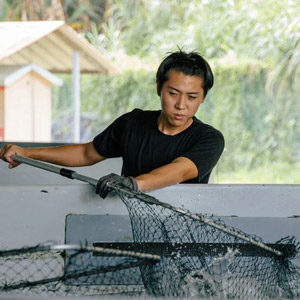Can you name any creepy freshwater aquarium fish? Below are eleven that you might recognize whether you have them in your own tank or have seen them while out shopping.
Silver Arowana (Osteoglossum bicirrhosum)
You may be familiar with this name, given how popular a fish this is in freshwater aquariums. They live for up to fifteen years, grow up to three feet in captivity, and are a fairly aggressive species, which makes them a challenging pet.
If you own the Silver Arowana (AKA Dragon Fish), you will likely know how important it is to set them up in a large tank that will accommodate their size and mimic their natural habitat. Otherwise, the fish will suffer, either through stress, developmental issues, or even jumping out of the tank!
Would you be able to distinguish a Silver Arowana from other fish species just by sight? The most defining characteristic of this fish is actually its fins. Keep an eye out for a small tail fin with dorsal and anal fins stretching all the way down to it on a long, slender body.
| Scientific Name: | Osteoglossum Bicirrhosum |
| Common Name: | Silver Arowana, Dragon Fish |
| Origin: | South America |
| Family: | Osteoglossidae |
| Max Size: | 9 inches (23 cm) |
| Social: | Aggressive |
| Care: | Advanced |
| Lifespan: | 15 years |
| pH: | 5 to 7.5 |
| Temperature: | 75 to 82 F (24 to 28 C) |
| KH: | 1 to 8 dKH |
| Diet: | Carnivorous |
| Tank Size (Minimum) | 250 gallons |
Axolotl (Ambystoma mexicanum)

This creepy freshwater aquarium fish isn’t technically a fish but an amphibian that is closely related to the Tiger Salamander! It is also verging on becoming extinct as of 2020 and is currently listed as critically endangered.
Appearance wise, it is clear to see that these species are amphibians instead of fish due to their external gills and the small arms protruding from their bodies.
An Axolotl actually requires a mix of fresh and saltwater in their tanks, known as brackish water, so you need to be comfortable setting up an aquarium of this type. In fact, they require a completely specific water recipe in order to survive! That’s why it is not recommended for beginner aquarists.
Axolotls are prone to many health concerns, including floating syndrome and various skin diseases that are sometimes difficult to treat. These have contributed to them becoming endangered.
| Scientific Name: | Ambystoma mexicanum |
| Common Name: | Axolotl, Mexican walking fish |
| Origin: | North America |
| Family: | Ambystomatidae |
| Size: | 6 to18 inches (over 12 inches is rare) |
| Care: | Advanced |
| Lifespan: | 15 years |
| pH: | 6.5 to 7.5 |
| Temperature: | 60 to 64 F (16 to 18 C) |
| KH: | 7 to 8 dKH |
| Diet: | Carnivorous |
| Tank Size (Minimum) | 20 gallons |
African Freshwater Pipefish (Enneacampus ansorgii)
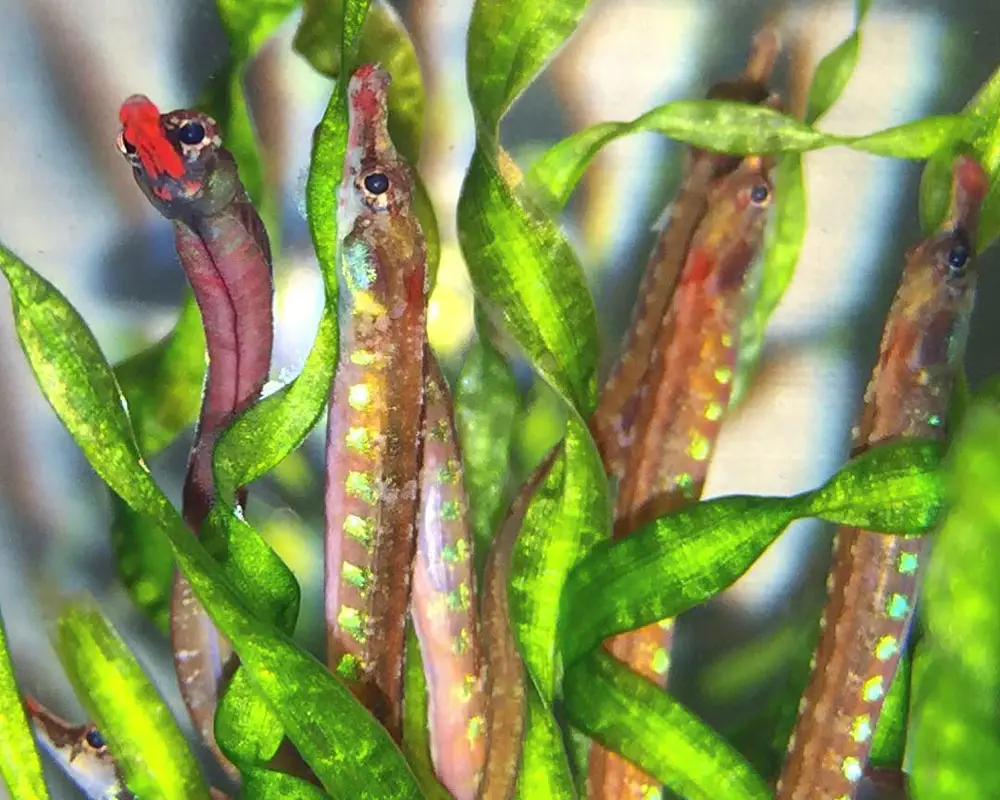
Also known as Dwarf Red Snout, this fish is incredibly rare in most aquariums and is very high maintenance when they are in captivity. Though many would recognize them due to their bright colors.
They are quite a curious species, so it is likely that if you are lucky enough to see some of the ones kept in captivity that there will be plenty of plants in the tank with them. But you will not see them mixing with other species when in their tanks unless it is snails, as they are very slow eaters!
African Freshwater Pipefish are also commonly bred in captivity instead of being caught and then sold on. This is because it is more difficult to care for a member of this species that has come from the wild.
| Scientific Name: | Enneacampus ansorgii |
| Common Name: | Freshwater Pipefish, Dwarf Red Snout |
| Origin: | Africa |
| Family: | Syngnathidae |
| Max Size: | 5 inches (13 cm) |
| Social: | Peaceful |
| Care: | Advanced |
| pH: | 6.8 to 7.8 |
| Temperature: | 78 to 82 F (26 to 28 C) |
| KH: | 10 to 18 dKH |
| Diet: | Carnivorous (tiny live foods) |
| Tank Size (Minimum) | 20 gallons |
African Butterflyfish (Pantodon buchholzi)

The appearance of this fish is what makes them stand out and is the reason for their name. The African or Freshwater Butterflyfish is named due to its large fins looking like a butterfly’s wings when they are being studied from the surface.
The African Butterflyfish is very unique in how it moves as it can glide along the surface of the water instead of surviving below the waterline like the majority of fish. Due to their “wings” (fins), they are able to fly!
This species, like the African Freshwater Pipefish, enjoy having lots of aquatic plants as they like to hide in them. Just make sure that there is enough space for them to swim along the top of the tank.
| Scientific Name: | Pantodon Buchholzi |
| Common Name: | freshwater butterflyfish, African butterflyfish |
| Origin: | West Africa |
| Family: | Pantodontidae |
| Max Size: | 5.1 inches (13 cm) |
| Social: | Aggressive |
| Care: | Advanced |
| Lifespan: | 5 years |
| pH: | 6.5 to 7 |
| Temperature: | 73 to 86 F (23 to 30 C) |
| KH: | 1 to 10 dKH |
| Diet: | Carnivorous |
| Tank Size (Minimum) | 40 gallons |
Ropefish (Erpetoichthys calabaricus)

Make sure that you don’t get this creepy freshwater aquarium fish confused with an eel. It is very similar in appearance as it has a long, thin body without a ventral fin. They are also possibly the easiest fish to care for on this list, so perfect if you are only beginning your aquarium.
If you are good to your fish and provide it with the best habitat, the Ropefish (or Reedfish) can survive up to 20 years! So, make sure that there are lots of rocks to provide them with plenty of hiding spaces, as well as vegetation that is likely to be found in their habitat in the wild.
Did you know that this fish also has lungs? Because of its relation to the Polypteridae family, Ropefish actually have lungs that help them to survive when the water quality isn’t good, by surfacing and breathing in some air.
| Scientific Name: | Erpetoichthys Calabaricus |
| Common Name: | reedfish, ropefish, snakefish |
| Origin: | West and Central Africa |
| Family: | Polypteridae |
| Max Size: | 16 inches (40 cm) |
| Social: | Peaceful |
| Care: | Intermediate |
| Lifespan: | 15 to 20 years |
| pH: | 6.0 to 7.5 |
| Temperature: | 73 to 86 F (23 to 30 C) |
| KH: | 5 to 20 dKH |
| Diet: | Carnivorous |
| Tank Size (Minimum) | 50 gallons |
Black Ghost Knife Fish (Apteronotus albifrons)
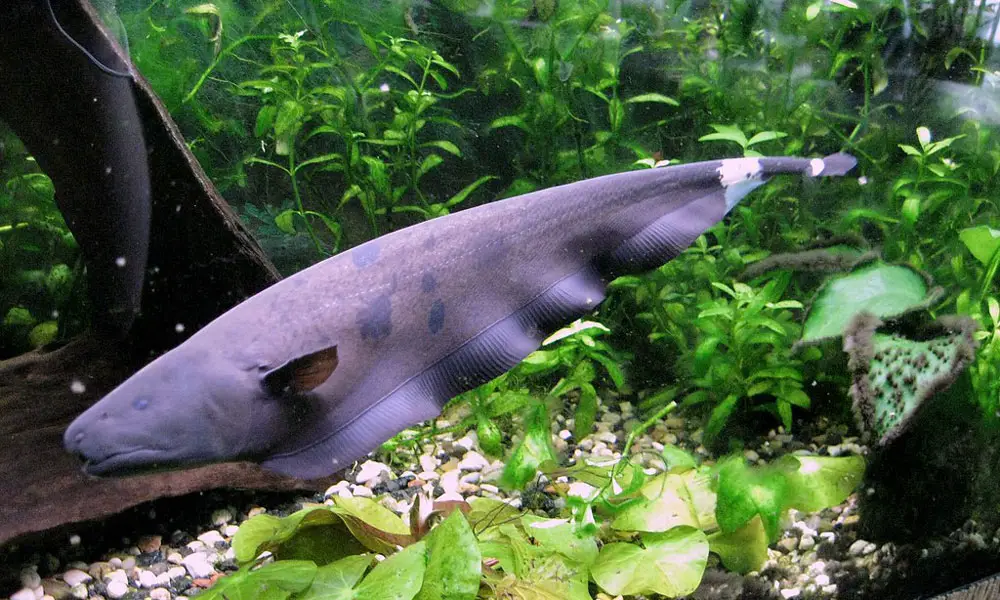
Another fish in this list that has a fairly distinct appearance is the Black Ghost Knife Fish. As you can probably guess from its name, this fish is actually shaped slightly like a knife with a slight curve to its thin form. It also doesn’t have any fins! Simply a small ridge where the fin usually would be.
Did you know that this is another fish that is mainly bred in captivity? Due to its popularity, the Black Ghost Knife Fish has been bred in captivity for years now, and it is far more likely that the ones you are seeing have never been in the wild before.
When preparing to care for a member of this species, remember to fill the tank with things reminiscent of their habitat; rocks, plants, logs, etc. A softer substance like sand on the bottom is crucial as this is where they will spend the majority of their time.
| Scientific Name: | Apteronotus albifrons |
| Common Name: | Black ghost knife fish, BGK |
| Origin: | South America |
| Family: | Apteronotidae |
| Size: | 14 to 18 inches (35 to 45 cm) |
| Social: | Peaceful |
| Care: | Intermediate |
| Lifespan: | up to 10 years |
| pH: | 6.5 to 8.0 |
| Temperature: | 75 to 82 F (24 to 28 C) |
| KH: | 5 to 10 dKH |
| Diet: | Carnivorous |
| Tank Size (Minimum) | 120 gallons |
Ornate Bichir (Polypterus Ornatipinnis)

This stunning fish is sometimes referred to as the “dinosaur eel.” It can be easily distinguished by its unique black and gold pattern.
If you already have some fish in the tank that you are hoping to put the Ornate Bichir in, it is important to remember that it will eat any fish that it considers to be small enough to be prey, even if it isn’t naturally aggressive species.
Something important to remember is that this fish likes to jump. Make sure that you have a close-fitting lid that will also allow it to breathe air from time to time, or it just might jump out!
| Scientific Name: | Polypterus Ornatipinnis |
| Common Name: | Ornate Bichir |
| Origin: | West Africa |
| Family: | Polypteridae |
| Size: | 24 inches (60cm) (18 inches on average in the aquarium) |
| Social: | Semi-aggressive |
| Care: | Intermediate |
| Lifespan: | up to 15 years |
| pH: | 6.5 to 7.5 |
| Temperature: | 77 to 83 F (25 to 28 C) |
| KH: | 1 to 10 dKH |
| Diet: | Carnivorous |
| Tank Size (Minimum) | 180 gallons |
Amazon Leaf Fish (Monocirrhus Polyacanthus)
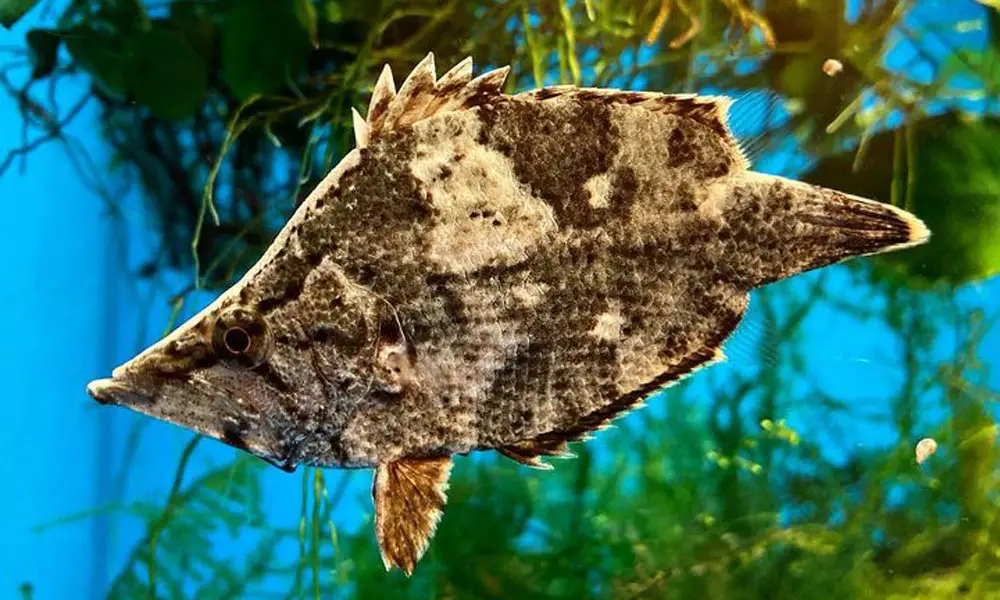
Can you guess what this fish looks like? You guessed right, a dead leaf! Its yellow or brown colorings and spiny fins help it to blend in with the debris on the waterbed.
It isn’t a fish that would do well sharing a tank with other species as it lies in wait for its food, so it is likely to eat any others in its space if they view them as prey.
The Amazon Leaf Fish prefers dimly lit habitats with plenty of driftwood and other objects that it can camouflage itself amongst. So, it is important that you provide them with plenty in the tank.
| Scientific Name: | Monocirrhus Polyacanthus |
| Common Name: | South American Leaffish, or Amazon Leaffish |
| Origin: | South American |
| Family: | Polycentridae |
| Size: | 3 to 4 inches (7.6 to 10.1 cm) |
| Social: | Aggressive |
| Care: | Advanced |
| Lifespan: | 5 to 8 years |
| pH: | 6.0 to 6.5 |
| Temperature: | 77 to 82 F (25 to 28 C) |
| KH: | 2 to 5 dKH |
| Diet: | Carnivorous |
| Tank Size (Minimum) | 20 gallons |
Freshwater Sole (Brachirus Selheimi)

The Freshwater Sole is quite small in comparison to the other fish in this list, reaching roughly five inches when fully mature. Their bodies are also flat and blend into the sand that is lying on the floor.
They eat smaller fish but should be alright in a tank with larger species so long as the others aren’t too aggressive or likely to beat them to the food source continuously.
| Scientific Name: | Brachirus Selheimi |
| Common Name: | Freshwater Sole, Freshwater Flounder |
| Origin: | Australia |
| Family: | Soleidae |
| Size: | 5 inches (13 cm) |
| Social: | Semi-aggressive |
| Care: | Advanced |
| Lifespan: | up to 15 years |
| pH: | 7.0 to 8.1 |
| Temperature: | 76 to 82 F (24 to 28 C) |
| KH: | 7 to 10 dKH |
| Diet: | Carnivorous |
| Tank Size (Minimum) | 55 gallons |
Freshwater Lionfish (Batrachomoeus Trispinosus)
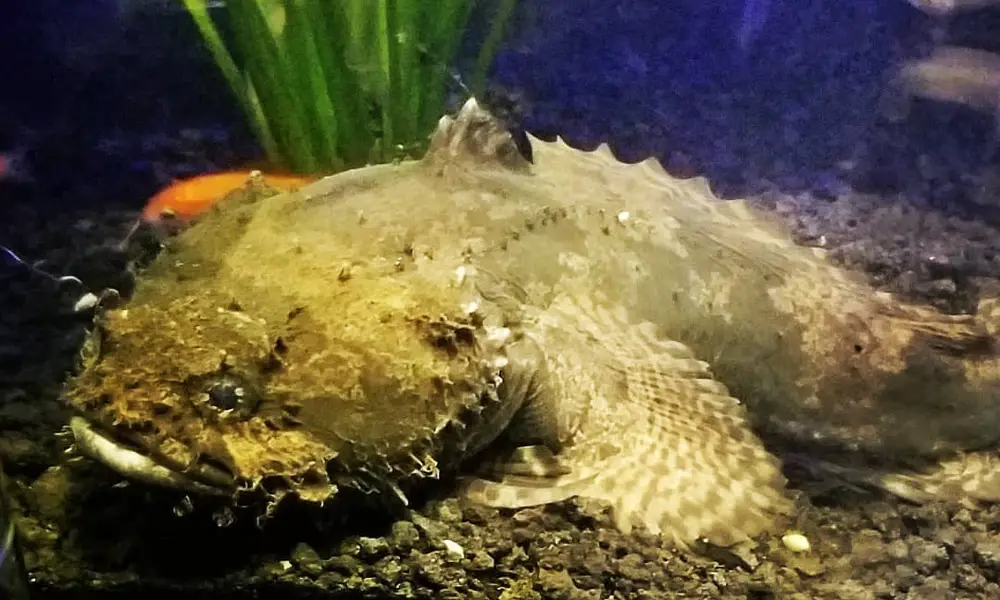
Have you ever seen a fish that was covered in spines? Well, this one is. The Freshwater Lionfish have spines covering its flattened body; although they aren’t venomous, they will hurt if you prick your finger on them!
To match its habitat, it is best to supply this fish with plenty of items they can use with their camouflage on the bottom of the tank because this is where they will spend most of their time. Also, make sure to get a large tank since they can become very big!
Like the Axolotl, the Freshwater Lionfish likes to have brackish water instead of freshwater, so make sure to have this in the tank for this toadfish relative.
| Scientific Name: | Batrachomoeus Trispinosus |
| Common Name: | Freshwater Lionfish, Freshwater Stonefish, Three-spined Frogfish, Toadfish |
| Origin: | Australia |
| Family: | Batrachoididae |
| Size: | 11.8 inches (29.97 cm) |
| Social: | Peaceful |
| Care: | Advanced |
| Lifespan: | up to 15 years |
| pH: | 7.5 to 8.5 |
| Temperature: | 72.0 to 82.0° F (22.2 to 27.8° C) |
| KH: | 7 to 10 dKH |
| Diet: | Carnivorous |
| Tank Size (Minimum) | 100 gallons |
Freshwater Frogfish (Antennarius Biocellatus)
There is no specific coloring that identifies this fish; however, it is rather angular, with an eyespot or two on its dorsal fin.
Freshwater Frogfish prefer brackish water but can also be found in freshwater. If you are looking into keeping one, then it is important to keep the salt level minimal to ensure they have the best chance of survival.
The slow-moving fish are another on this list that likes to wait until their prey approaches them. As they move slowly, it is best to keep them separate from any fish that may reach the food supply before them.
| Scientific Name: | Antennarius Biocellatus |
| Common Name: | Freshwater Frogfish, brackish-water frogfish, the fishing frog |
| Origin: | Australia |
| Family: | Antennariidae |
| Size: | 5.5 inches (14 cm) |
| Social: | Semi-aggressive |
| Care: | Advanced |
| Lifespan: | up to 15 years |
| pH: | 7.0 to 8.2 |
| Temperature: | 76 to 82 F (24.4 to 27.8° C) |
| Salinity: | 0 – 35ppt |
| Diet: | Carnivorous |
| Tank Size (Minimum) | 40 gallons |
Final Thoughts
If you are looking to purchase one of these creepy freshwater aquarium fish, here are some things to keep in mind:
- Whether they prefer freshwater or brackish water.
- How they prefer their environment.
- How big they will grow as an adult.
- Whether they interact well with others.
The fish listed here may have some similarities, but they are all unique in their own ways and require attention to different areas.
Do you have any other creepy freshwater aquarium fish that you would like to share? Let us know in the comments section below!

